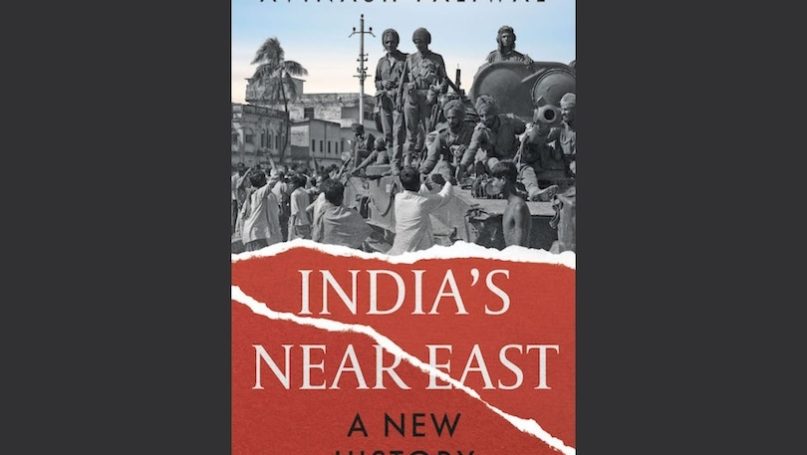
India’s Near East: A New History
By Avinash Paliwal
Hurst, 2024
The sudden collapse of the Sheikh Hasina government in Bangladesh on 5 August evoked a mixed emotion of surprise, anger, and worry in India. However, what’s missing from the discourse is a sense of introspection of India’s neighbourhood policy, especially its troubled eastern flank. This is where Avinash Paliwal’s latest book, India’s Near East, fills the void by exploring the contours of India’s near east policy in terms of protection of its territorial integrity, protection of Hindu minorities and management of ethnic conflicts in its periphery which are the very same issues that concerned the Indian intelligentsia and establishment in the post-Hassina era. Thus, the book gives the reader a glimpse of India’s trials and tribulations in its near east over seven decades in a descriptive rather than prescriptive manner.
The book is divided into three parts and ten chapters, each covering India’s particular approach to its near east, i.e., solidarity, security, and connectivity, chronologically. The solidarity part covers the 1947-1970 period and describes how India deals with the aftermath of partition and the initiation of ethnic insurgencies in its near east. The security part focuses on the 1971-1990 period. It covers the Bangladesh liberation war, the assassination of leaders like Sheikh Mujib and Jia Ur Rahman, and India’s support of pro-democracy elements inside Myanmar. The last part, i.e., connectivity, covers the 1990-2024 period and describes how India calibrated its near east policy to adjust to new realities of economic liberalization and the collapse of the Soviet Union.
The book’s biggest strength lies in the fact that it can sustain the author’s central argument that India’s diplomacy in its near east state vis-a-vis East Pakistan, Bangladesh, and Myanmar is intricately linked to its state project in the north-east as a common thread binding the complete text. Consequently, the reader can extrapolate contemporary events like India’s ambiguity in engaging the military junta post-2021 coup or Delhi’s tightrope walk with Bangladesh regarding the passage of the Citizenship Amendment Act. The historical analysis framework of the book enables readers to unpack vexed issues like the xenophobic streak in Myanmar regarding Rohingya Muslims or India’s continued reliance on repressive measures like AFSPA (Armed Forces Special Power Act) in the northeast.
Through meticulous use of archival sources and interviews with the principal protagonists, the author is able to uncover interesting incidents like coordination between India’s Intelligence Bureau (IB) and Pakistan’s Inter-Services Intelligence (ISI) on containing communism in Burma or India’s willingness to intervene militarily in Bangladesh in 2009 to save Sheikh Hassina’s life following the Bangladesh Rifles (BDR) mutiny in 2009. The author also demolishes many prevalent notions through his research, like Nehru unsentimentally dealing with issues of secessionism. After Nei Win came to power in Burma, India accepted the coup by Ne Win against U Nu and the mass exodus of Burmese India to secure Burmese cooperation in ongoing operations against Naga militants. He also identified many research gaps, like India’s uncharacteristic reaction to the 1954 East Pakistan elections. This election in Pakistan happened with the backdrop of Bengali language agitation by the United Front. The United Front landslide election victory was seen as a positive development by Nehru who believed that a Pakistan ruled by a non-Punjabi elite could lead to the resolution of an outstanding dispute between India and Pakistan. Hence, the author is able to establish a hitherto unexplored link between India’s eventual intervention in 1971 and it’s perception of Pakistan’s ruling elite in ethnic terms in the 1950s, a critical aspect which requires further investigation.
The book also deals with India’s much talked about “two and a half front” security dilemma, whose resolution has been a key driver of India’s near east policy. India’s relationship with Pakistan and China is in a “deep freeze” following India’s abrogation of Article 370 and Galwan’s clash with China in 2020, which reignited India’s security dilemma, and the author’s attempt to historicize this phenomenon is highly relevant.
Yet despite the above-mentioned features, the book’s contemporary relevance lies in its ability to shed light on India’s neighborhood conundrum. India’s inability to adopt a coherent and continuous posture vis-a-vis its eastern neighbors is a historical truth. It provides an instructive guide to all South Asian scholars on New Delhi’s dilemma in dealing with its smaller counterparts. India’s vacillation between realism and liberalism in dealing with South Asian states stems from its insecurities regarding its periphery and the role of external powers like China and the United States.
Yet the books’ highly contemporary relevance also laid bare its weakness since the author, in their attempt to use an “outside-in” lens, neglects the role of the communal policies of its neighbors, especially Pakistan, in shaping India’s response. Communalism or ethnic nationalism in South Asia has a historical context and strengthens itself through a vicious action-reaction cycle; hence analysis of the response of an asymmetrical power like India can not be complete without adequately considering the role of colonial powers and its neighbors. Also, in the latter part of the book, for example, while explaining India’s connectivity push in its near east, the author adopted a highly monocausal approach of fixating on regional dynamics and neglected the sea change in the global balance of power in the post-Cold War era.
India’s near east is a much-neglected region in Indian academia since our policymakers and academics have traditionally been Western-oriented in their outlook due to the size and significance of Pakistan in our imagination. This poverty of scholarship is the primary reason why popular discourse in India fails to appreciate the behavior of its eastern neighbor, such as the toppling of the Mujib Ur Rahman statue by student protestors following the events of August 5. The book’s ability to offer an insight into the multiple narratives prevalent in the highly diverse ethnic landscape of India’s Near East is its single biggest contribution to existing scholarship on South Asia in general and India’s Near East in particular.